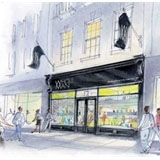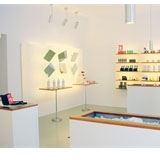Face facts

Making a cosmetic brand stand out in-store when it is surrounded by its competitors is a tough challenge. How do you differentiate products without overloading customers with information? Clare Dowdy finds out
It’s easy for the department stores, and even easier for the single brand outlets. These environments allow cosmetics and skincare products room to breathe – so to speak – and they are staffed by informed and well-groomed brand representatives.
In the multi-branded environment of the high street, however, it’s a different story. A plethora of brands compete for space and attention, and in-the-know assistants are few and far between, so displays have to work that much harder to attract attention.
What’s more, cosmetics and skincare variants are proliferating at an ever-increasing rate. Common or garden moisturiser and mascara are now competing with the latest ‘revolutionary development’, such as anti-aging products.
Regardless of all the so-called product innovation, single-brand retailers like to operate environments that are strict on clarity, with regimented product displays and a tendency towards simplicity. New men’s skincare store Skeen in Paris is an example of this. It was created by Emmanuel Fenasse, an independent designer. ‘We divided the wall display into 12 columns because of the 12 products,’ Fenasse explains. ‘Each product is easy to recognise by the colour. The name of the product is written vertically on black ‘bookmarks’. It’s a real wall of products, so all the shelves are the same size, all are floor-to-ceiling, and all are made of wood. The aim is to give the impression of profusion and appetite, like a grocery.’

Wholeman (pictured right), a new concept that opens on Bond Street in September, is – as the name suggests – another male-friendly environment, this time trading in its own-brand range of vitamins and supplements, as well as skincare and grooming products, treatments and massage. And this time, a key display material will be pumice, according to Steve Collis, joint managing director of JHP, which designed the store.
However, it is in multi-brand environments such as Boots and Superdrug where designers really have to work hard to make noise for their clients.
‘Everybody is trying to get the maximum visual impact. The result can be total visual chaos. If there is too much going on, the customer gets confused. I imagine it’s quite common for people to walk away because they can’t make their minds up,’ says Ian Caulder, creative director of Caulder Moore, which is busy working on London perfume house Ormonde Jayne’s new Old Bond Street store.
In recent months, there have been fresh attempts to draw the audience’s attention towards French cosmetics brands Bourjois and Olay.
Dragon has attempted to inject a bit of department store thinking into the limited space available in Boots with its work for Bourjois, according to Dragon creative director Samantha Dumont. The consultancy went for differentiation through illustration, with Claire McMahon creating a quirky but stylish character for the brand. Dumont explains: ‘It’s unusual to have illustration in this sector. While photography can add style, it can become interchangeable. Illustration gives a level of personality.’
Meanwhile, Clockworx Design was able to sink its teeth into a new product line: Olay’s self-tanning moisturiser, which goes by the name of Everyday Sunshine. ‘Cosmetics are small items, so the unit had to be easy to access – for customers as well as store staff, who will need to replenish it. On top of that, it had to build brand identity, and communicate the products’ benefits,’ explains Dan Smith, managing director of Clockworx Design, which created the unit that has gone into Boots and Superdrug.
As Caulder points out, merchandising units for new product ranges that make bold claims face quite a challenge. ‘Consumers aren’t sure how much to believe. They need brands to have credible backing, from research to endorsement,’ he says.

Yet despite such backing, savvy consumers will still research the market. ‘So a brand needs emotional attachment, as well as research and endorsement,’ adds Caulder. And that’s expressed through display and presentation, communication and point-of-sale.
It seems as if the most interesting design work in this sector must be hunted down, for it is unlikely to turn up in the obvious places. Breathe (pictured above left), a one-off outlet in Berlin, was one of the pioneers of clean, natural and contemporary interiors. Whether this look can trickle down into other contexts remains to be seen. However, this is one sector where designers really have to strive to express points of difference, however unconvincing those differences are.
-
Post a comment




